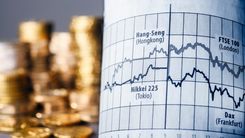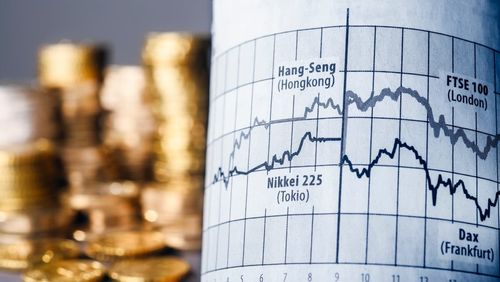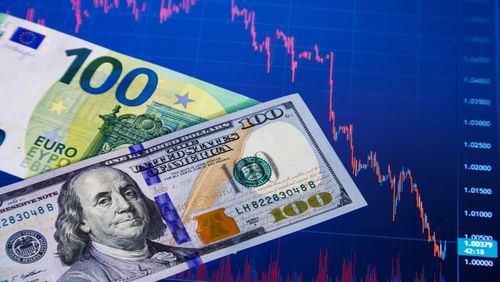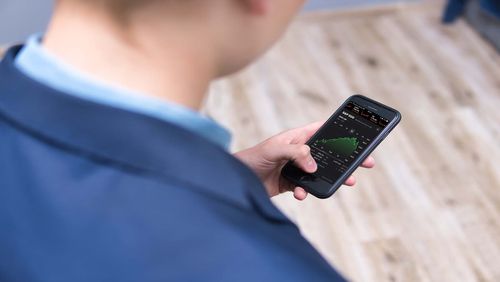Trading CFDs is one the most popular methods of stock market trading. Learn how to do it in this beginners guide.
Trading CFDs
What are CFDs?
CFD stands for Contracts for Difference.
A CFD is an agreement between two parties to exchange the difference in the value of a financial market between the time the contract (trade) is opened and the time it is closed.
You can trade CFDs on markets like shares, foreign currency (Forex), indices, bonds, ETFS, and commodities.
CFDs are what’s called Derivatives. That means the price you trade comes from the underlying market value.
For example, if you were to trade US crude oil CFDs on Markets.com, the price would come from the underlying value of the US crude oil futures contract (WTI).
You don’t own the underlying asset when trading CFDs. You buy or sell contracts by speculating on how you think the market will move.
By trading CFDs you are taking a Position. A Position is your exposure to the market, i.e., the value of the CFDs you wish to trade.
Benefits of trading CFDs
CFDs are a great way to get started in the world of trading. They have lots of benefits that make them a smart choice for first-time traders.
Efficient use of your capital
Capital is the money you put down to start trading. With CFDs, you can use that more efficiently.
You trade using your margin. This gives you leverage. We will go into more detail on these two aspects of CFD trading later.
For now, it means you only have to put down a fraction of the trade’s full value to open a position. That lets you start trading with a small budget.
Flexibility
Because you are trading agreements to exchange differences in the opening and closing points of a position, CFDs offer flexibility in how you can trade.
CFDs let you trade Long or Short.
In CFD trading, you trade long is if you believe prices will go up.
If you think prices will rise, you buy your contracts and take a Long Position.
You trade short if you believe prices will go down.
If you think prices will drop, you sell your contracts and take a Short Position.
This means you can trade on markets that are going down as well as up and still potentially make a profit. This offers traders quite a lot of flexibility.
No Stamp Duty
In the UK, you do notpay stamp duty on a CFD trade. This is because you do not take ownership of any of the assets you are buying and selling.
Please be aware that tax treatment of CFD trading will depend on your individual circumstances and be subject to change.
Variety
As CFDs can be traded across lots of different markets, you have plenty of scope to choose sectors, companies, and geographies that you think will help you reach your trading goals.
Markets available include:
- Shares – Shares in individual companies like Tesla, Apple, Amazon, Lloyds, Vodafone, Volkswagen etc
- Foreign currency (Forex) – US Dollars, Euros, Pounds, and so on
- Indices – Stock markets like FTSE 100, S&P 500, Dow Jones, DAX, etc.
- Commodities – Assets like oil & gas, crops, and so on
Markets.com offers 2,200 different instruments for you to choose from on our multi-asset platform.
Risks of trading CFDs
There are inherent risks when it comes to trading any financial product like Contracts for Differences.
Please read the below carefully and understand the potential risks you will undertake if you decide to start trading CFDs.
CFDs are Leveraged Products
Leveraged products like CFDs give you market exposure for a percentage of the full trade you wish to make. This means that you can potentially make profits if the market moves in your favour.
You can also lose money if the market moves against you and you are not using adequate risk management tools.
Let’s look at an example.
If you place a CFD trade worth £1,000 with a margin rate of 5%, the margin requirement to open this trade would only be £50.
However, if the price of the trade moves against you by 10%, you would lose £100, i.e., double your initial stake in your initial CFD trade.
This is because your exposure to the market, i.e., your risk, is the same as if you had purchased £1,000 worth of physical shares, foreign currency, commodities and so on.
This means that any move in the market will have a greater effect on your capital than if you had purchased the same value of shares.
Market volatility & gapping
Markets are inherently volatile. They can go up, but they can also go down.
Outside effects like government policies, unexpected information and changes in market conditions mean prices can fluctuate.
Small changes may have a big impact on returns when it comes to trading CFDs.
Unfavourable effects on the underlying asset’s value may cause the trade provider to demand further margin payments. These are called Margin Calls.
If a margin call cannot be met, the provider may close your position. Alternatively, you may have to sell at a loss.
Another risk associated with market volatility is Gapping.
Gapping happens when prices of instruments, i.e., CFDs being traded, suddenly shift from one level to another skipping any intermediate levels.
This may mean Stop-loss Orders are applied at an unfavourable price. A stop-loss order is a market risk tool that helps manage risk by closing a position once an instrument or asset reaches a certain price.
Market volatility’s risk and impact can be lowered by applying boundary or guaranteed stop-loss orders to your trades.
Client Money Risk
There are client money protection laws that apply to CFDs in countries where contract trading is legal.
They are designed to protect investors from potentially harmful practices from irreputable CFD providers.
Money transferred to CFD providers must be kept separate from the provider’s money. This is to prevent CFD providers hedging their own investment.
Even so, some laws may not prohibit clients’ money from being pooled into one or more accounts.
A provider withdraws an initial margin when a contract is agreed upon. The provider also has the right to request further margins from pooled accounts. If clients in the pooled account cannot meet margin calls, the CFD provider has the right to draw from the pooled account. This can have a negative impact on returns.
How to trade CFDs
Here is how to get started trading Contracts for Difference.
Margin & Leverage
Before you get started, it’s vitally important you understand the concepts of Margin and Leverage.
Margin is the money you need to lay down in order to open a leveraged trade, i.e., start trading CFDs.
Margin and leverage are related terms.
In short, the leverage ratio determines the amount of margin you need to have in your account.
Margin rates vary across different regions and asset classes.
Leverage allows you to gain full exposure to a market by investing only a fraction of the capital you would normally require.
Upon opening a transaction, the margin value will be required and held as collateral to be maintained until termination of the relevant transaction.
The amount of the margin payments is dependent on the leverage ratio of the CFD, the underlying financial instrument, and the contract value of the transaction.
Let’s look at an example.
If you are trading FX with a leverage ratio of 30:1 – equivalent to a margin rate of 3.33% – it means you can control a trade with a notional value of £3000 with only £100 of margin.
The minimum level required for maintaining positions is 50%.
In the above scenario, once opening the trade you would need to maintain at least £50 of available funds in your account to satisfy the margin requirements.
Please note: if margin thresholds are not met, then your positions may be closed.
Set your budget & fund your account on Markets.com
Firstly, set yourself a trading budget.
If you are a beginner trader, you might want to start low.
£100 is the minimum amount of funds you need to start trading with Markets.com. This is just to open your account. You do not need to trade the £100. If you have the correct margin funds on an instrument or asset, you could trade £50.
The other available currencies are: USD/EUR/DKK/NOK/SEK/PLN/CZK/AED
Got more experience and confidence? You may want to add more funds – but this is only advised if you have previously traded CFDs before.
If you want to try your hand at trading without risking your money, then open a Demo account. No money will change hands and you can explore the Markets.com platform without any of the risk.
Build your trading plan
Think about what you want to achieve from trading.
- How much profit are you hoping to make?
- How much time can you realistically spend trading?
- How much can you safely spend?
- Are you comfortable assuming the risk?
- What does acceptable loss look like to you?
If you can answer these questions, it will help you make more informed trading decisions that suit your individual goals.
Research your opportunities
With over 2,200 assets to choose from, you will find opportunities to suit you at Markets.com.
In the platform, you can search across CFDs on various sectors, such as:
- Shares
- Foreign currency (Forex)
- Indices
- Commodities
You can also use Markets.com unique XRay and Insights analysis to help you decide.
XRay is our streaming service, featuring videos and content from market experts. It covers everything from leading stocks to currency movements, to current affairs information.
Insights is much the same: market news delivered by professionals.
These tools will aid you in choosing the correct CFDs for you.
Open your first position
When you have decided which market you want to trade, you are ready to start trading.
The first thing to decide is whether you want to go long or short.
In CFD trading, you trade Long is if you believe prices will go up.
- If you think prices will rise, you buy your contracts and take a Long Position.
You trade Short if you believe prices will go down.
- If you think prices will drop, you sell your contracts and take a Short Position.
Once you’ve taken your position, your profit or loss will move in line with the underlying market price.
You’ll be able to monitor this on our platform using the various performance and analytical charts available.
You can also do this manually by placing the same trade you originally placed but in the opposite direction.
For example, if you opened your position by buying, you could close by selling the same number of contracts at the sell price – and vice versa.
Your profit or loss is calculated by multiplying the amount the market moved by the size of your trade.
Buy & Sell Prices
Buy and Sell Prices are very important.
When trading CFDs, you will be offered two prices based on the instrument you are trading’s underlying value.
- The Buy Price is what you bid to purchase an instrument
- The Sell Price is the seller’s offer
Buy prices will always be higher than the instrument’s current underlying value. The price to sell will always be lower.
The difference between the two prices is called the Spread.
Number of contracts
A key aspect of CFD trading is selecting how many contracts you wish to trade.
Each market has its own minimum number of contracts.
For example, the FTSE 100 has a minimum contracts number of one.
There is no maximum contracts number. The level you can buy will depend on how much capital you originally put down, your budget, and so on.
Stops & limits
Stops and Limits are put in place to minimize trading risk.
Remember: CFDs are leveraged products. You only ever need to put down a small deposit to gain exposure to the full value of the trade.
This means your capital goes further but also means that you could lose more than your initial outlay.
To help restrict your potential losses, you might choose to add a stop. Stops automatically close your position when the market moves against you by a specified amount.
Limits are the opposite to Stops.
They close your position when the market moves a specified distance in your favour. Limits are a great way to secure profits in volatile markets.
An example CFD trade
Let’s put all the above into practice.
You want to trade shares in Apple as CFDs.
The Apple shares have an underlying market price of 314.6p. The sell price is 314.5p and the buy price is 314.7p.
Apple is expected to make an earnings announcement soon. Market forecasts suggest Apple’s earnings release will be positive and the company is performing well.
Because you think the price will go up, you buy 2,000 Apple share CFDs at the buy price of 314.7. This is equivalent to buying 2,000 Apple shares.
As CFDs are leveraged products, you do not need to put up the full value of the shares you wish to trade. You only need to cover the margin. This is calculated by multiplying your exposure with the margin factor for the market you are trading.
In this example, the margin factor is 20%. Your margin would be 20% of the total exposure of your trade:
- The total exposure is £6,294 (2,000 CFDs x 314.7p).
- 20% of £6,294 = £1258.80.
If the CFD value rises
Your prediction was correct! Apple’s earnings announcement shows the tech giant has had a very good quarter. Sales are up, and its share price has risen.
You decide to close your position when it reaches 354.3p, with a buy price of 354.4p and a sell price of 354.2p.
You reverse your trade to close a position, so you sell your 2000 CFDs at a price of 354.2p.
Now you can calculate your profit.
To do that, you multiply the difference between the closing price and the opening price of your position by its size:
- 354.2 – 314.7 = 39.5
- 39.5 x 2,000 (the number of your CFDs) = 790
- Your profit = £790
Remember: You will also need to pay a commission fee, capital gains tax, and any potential overnight fees that have affected your trade.
If the share price goes down
Bad news. Apple’s earnings are worse than the market anticipated. Its share price has fallen, and you decide to cut your losses and sell your CFDs.
The sell price is 288.7. That means your position has moved 26p against you.
The process for calculating your loss is the same as profit:
- 288.7 – 314.7 = -26.
- -26 x 2,000 = 520
- Your loss = £520
Those are the basics of what CFDs are and how to trade them.










